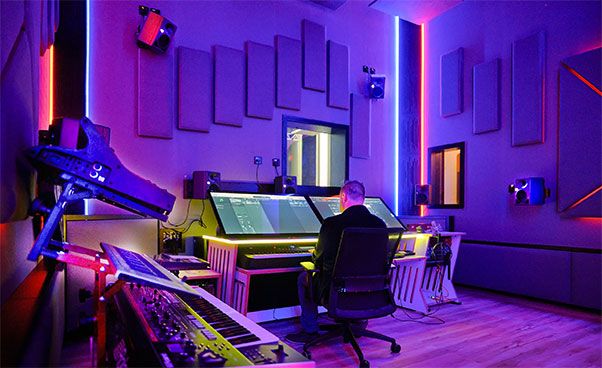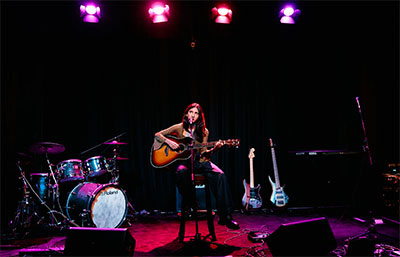
Abu Dhabi’s BarCoe Studio has completed its metamorphosis to BarCoe Studios, a new facility designed and built for video content creation for musical artists, live music production, and recording, video and audio editing. The facility comprises a live room with a stage and space enough to record a full orchestra, a songwriting room for artists, a vocal booth, drum room, video editing suite and main control/mastering room.
Sean Barcoe founded the original studio with the aim to provide a space where artists could explore their creativity. ‘From the outset, we had world-class ambition,’ he says. ‘We knew that our region is a universal contender for quality and excellence. We wanted to showcase the talent in the region to a global audience. This studio epitomises that dream turning into an actuality.’
The new facility is the continuation of the mission Barcoe began ten years previously with the goal of taking regional musicians to the world stage. At the time Abu Dhabi was leading the Gulf region’s re-invention, and projects such as Masdar City business and technology hub and the twofour54 media, entertainment and entertainment hub were attracting young talent to the Abu Dhabi. The new BarCoe space is designed for artists to fully express their creativity and make their work market-ready for worldwide release.
The venture has called on top-tier Neumann and Sennhieiser equipment with support from technical and audio experts equal to its standards. ‘We have been fortunate with this project in the sense that our relationship with the end-user is already well established,’ says Sennheiser Middle East Head of Technical Sales & Application Engineering for Professional Audio, Ryan Burr. ‘This has meant that we have been involved from the concept to its delivery and established links between the end-user and other vendors to ensure that the design complies with standards related to how the content will be consumed.
 ‘This includes following guidelines set by Dolby for room configuration and loudspeaker positioning to create and mix Atmos for Music content. Thankfully, this project has been relatively smooth and has given us the time needed because of our early involvement. That’s not to say it hasn’t been without its challenges, but those were more from a construction point of view and the setting up of the IT network.
‘This includes following guidelines set by Dolby for room configuration and loudspeaker positioning to create and mix Atmos for Music content. Thankfully, this project has been relatively smooth and has given us the time needed because of our early involvement. That’s not to say it hasn’t been without its challenges, but those were more from a construction point of view and the setting up of the IT network.
‘Because BarCoe Studios is unique in the region in terms of how advanced its technology is, it is certain to win the interest of paying custom,’ he continues. ‘This will not only include local artists, but also corporate entities and government establishments looking to have their next promo video or music as unique as current technology will allow. This return on investment is what funds the advancement of the facility and Sean’s passion for what he does. It is also a future investment for us here at Sennheiser in terms of what he does next.’
The BarCoe Studio is a milestone in Sean Barcoe’s quest to bring regional talent to the attention of international audiences. Driven by passion and a dedication to growth, he has tapped into the diversity of the UAE and surrounding countries to showcase the local talent of Emirati and GCC artists, non-Emiratis born in the country and others who consider the region as their second home. The spectrum of creativity spans the globe, traverses continents, and covers all the ethnicities in the country: a melting pot of cultures, flavours, and sound.
The completed BarCoe Studios facility will not only give artists of the region a state-of-the-art facility to hone their skills and learn about studio technology but show them how it can be used as part of the process to create more unique and interesting content.
To date, the studio has recorded five EPs and filmed three music videos for its in-house label artists. The stage, fully equipped and rigged, has hosted these productions, embodying an ethos of comprehensive artistry.
For design the objective was clear and the control room had to meet the stringent requirements of Dolby’s standards. The meticulous approach to acoustic design was matched by the choice of equipment. To this end, Neumann was the go-to partner and enabled the studio to construct a control room that is an engineer’s dream. It is equipped with a Dolby Atmos 7.1.4 set-up, with aspirations to expand to a 9.1.6 configuration in due course.
The paramount consideration in the studio’s design was the Atmos room – its name a nod to the immersive Dolby Atmos technology. Its dimensions and specifications were not left to chance but follow the requirement of precise standards, creating an auditory sanctuary where sound is not just heard, but felt in its full dimensional spectrum.
Following closely in importance was the live room, a versatile space designed to serve multiple purposes from recording audio to hosting video shoots and live performances, and staging album launch events. Striking a balance between the visual and auditory, particularly in the live room, was crucial. The studio is now moving into virtual production, aiming to incorporate spatial audio into live music experiences.
The studio was already equipped with the first Neumann M 49 V Set microphones, and an array of U 87 and TLM 103 mics, but this stage of the project is more about the monitors with every functional room in the facility now outfitted with Neumann loudspeakers. Video Editing has KH 310s and the songwriting room has KH 120s.The Main Mastering/Control room has the region’s first 7.1.4 over AES67 configured monitoring system for Atmos music creation and mixing comprising 13 KH 120 II AES67 and four KH 750 DSP AES67 subs.
The design process for the main control room required Sennheiser Technical Application Engineering team (TAE) members Ryan Burr and Marcus Blight to use Dolby’s DARDT (Dolby Atmos Room Design Tool) room configuration software to come up with the optimum loudspeaker configuration and positioning before attending the site to confirm the locations.
The AES67 network then needed to be configured using a Merging Technologies Anubis as the hub for routing and control by the Sennheiser TAE team onsite. Only then could the process of aligning the loudspeakers to the room be completed and checked using Neumann’s MA 1 hard/software tool for acoustic calibration and room correction before playback and listening could finally take place.












